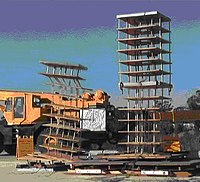
Photo from wikipedia
Abstract The dynamic behavior of tubular steel wind turbine towers is investigated, with emphasis on discussing how the effort to avoid resonance of the soil-foundation-tower system, by keeping its eigenfrequencies… Click to show full abstract
Abstract The dynamic behavior of tubular steel wind turbine towers is investigated, with emphasis on discussing how the effort to avoid resonance of the soil-foundation-tower system, by keeping its eigenfrequencies outside specific ranges around the rotor (1P) and blade-passing (3P) frequencies, influences tower optimization. For modern, tall towers avoidance of resonance becomes critical compared to other structural design checks, such as buckling and fatigue. Considering that the rotor and blades have predefined mass and rotation frequencies, the tower’s fundamental frequencies should be controlled considering the cross-sectional properties of the tower as well as the flexibility of its foundation. The objective of the optimization problem formulated in this work is to reduce tower weight, while satisfying the resonance and buckling criteria and considering restrictions pertaining to fabrication, transportation and erection. The vibration modes and frequencies of a 120m tall tower are determined via detailed as well as simplified finite element models, with the latter proving to be sufficiently accurate. The dependence of the tower’s vibration frequencies on the soil and foundation is also investigated. The numerical models are introduced into the high performance optimization computing platform (HP-OCP), to obtain an optimum distribution of tower shell thickness over the height.
Journal Title: Procedia Manufacturing
Year Published: 2020
Link to full text (if available)
Share on Social Media: Sign Up to like & get
recommendations!